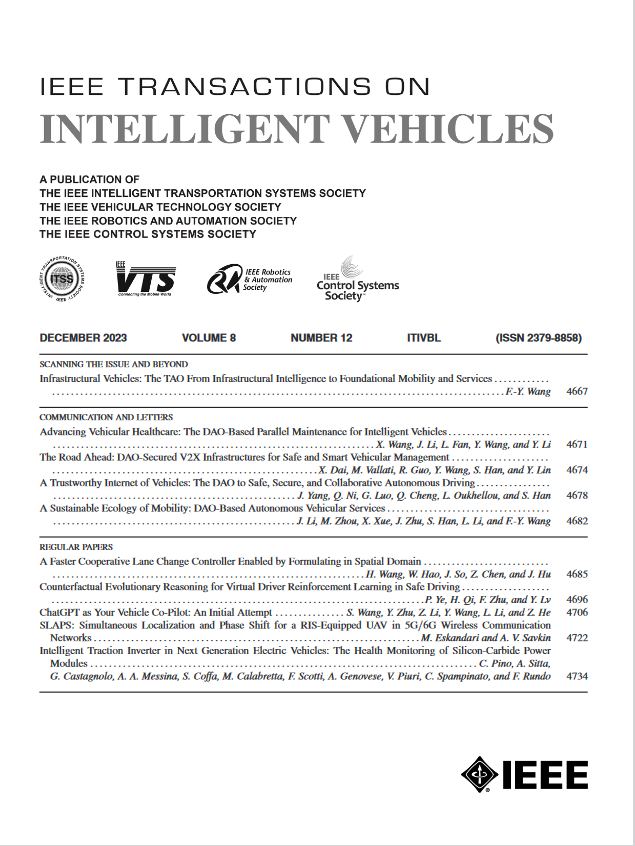Adaptive Entropy Multi-Modal Fusion for Nighttime Lane Segmentation
IF 14
1区 工程技术
Q1 COMPUTER SCIENCE, ARTIFICIAL INTELLIGENCE
引用次数: 0
Abstract
Lane segmentation at night is a challenging problem in autonomous driving perception, which is beneficial to improve the robustness of the application. Existing methods has shown great performance in the benchmark dataset, however, they do not consider the bad lighting scenes in practical applications, for example, the performance of the lane segmentation algorithm will be greatly affected at night. In this paper, we propose a novel multi-modal nighttime lane segmentation algorithm, which utilizes camera and LiDAR for complementary information. We illustrate the role of image entropy in showing the distribution of light at night, and propose an adaptive entropy fusion method to obtain the spatial relationship between entropy and modalities to adapt to different lighting scenes. The features of narrow and long lanes are more likely to be lost at night, a lane feature enhancement module is proposed to enhance the network's ability to capture lane features. Extensive experiments and analysis demostrate the effectiveness of our method against the state-of-the-art semantic segmentation and lane segmentation approaches on SHIFT dataset at night. Extensive experiments conducted on SHIFT dataset at night demonstrate that the proposed method achieves the state-of-the-art performance, 88.36%@14.06fps and 87.24%@26.88fps on SHIFT dataset at night, having the capability for real-time applications.自适应熵多模态融合夜间车道分割
夜间车道分割是自动驾驶感知中的一个具有挑战性的问题,它有利于提高应用的鲁棒性。现有的方法在基准数据集中表现出了很好的性能,但是在实际应用中没有考虑到光线不好的场景,例如在夜间车道分割算法的性能会受到很大的影响。在本文中,我们提出了一种新的多模态夜间车道分割算法,该算法利用摄像头和激光雷达进行互补信息。本文阐述了图像熵在显示夜间光线分布中的作用,提出了一种自适应熵融合方法来获取熵与模态之间的空间关系,以适应不同的照明场景。针对夜间较窄、较长的车道特征更容易丢失的问题,提出了车道特征增强模块来增强网络对车道特征的捕捉能力。大量的实验和分析证明了我们的方法在夜间SHIFT数据集上对最先进的语义分割和车道分割方法的有效性。在SHIFT夜间数据集上进行的大量实验表明,该方法在SHIFT夜间数据集上达到了最先进的性能,分别为88.36%@14.06fps和87.24%@26.88fps,具有实时应用的能力。
本文章由计算机程序翻译,如有差异,请以英文原文为准。
求助全文
约1分钟内获得全文
求助全文
来源期刊

IEEE Transactions on Intelligent Vehicles
Mathematics-Control and Optimization
CiteScore
12.10
自引率
13.40%
发文量
177
期刊介绍:
The IEEE Transactions on Intelligent Vehicles (T-IV) is a premier platform for publishing peer-reviewed articles that present innovative research concepts, application results, significant theoretical findings, and application case studies in the field of intelligent vehicles. With a particular emphasis on automated vehicles within roadway environments, T-IV aims to raise awareness of pressing research and application challenges.
Our focus is on providing critical information to the intelligent vehicle community, serving as a dissemination vehicle for IEEE ITS Society members and others interested in learning about the state-of-the-art developments and progress in research and applications related to intelligent vehicles. Join us in advancing knowledge and innovation in this dynamic field.
 求助内容:
求助内容: 应助结果提醒方式:
应助结果提醒方式:


